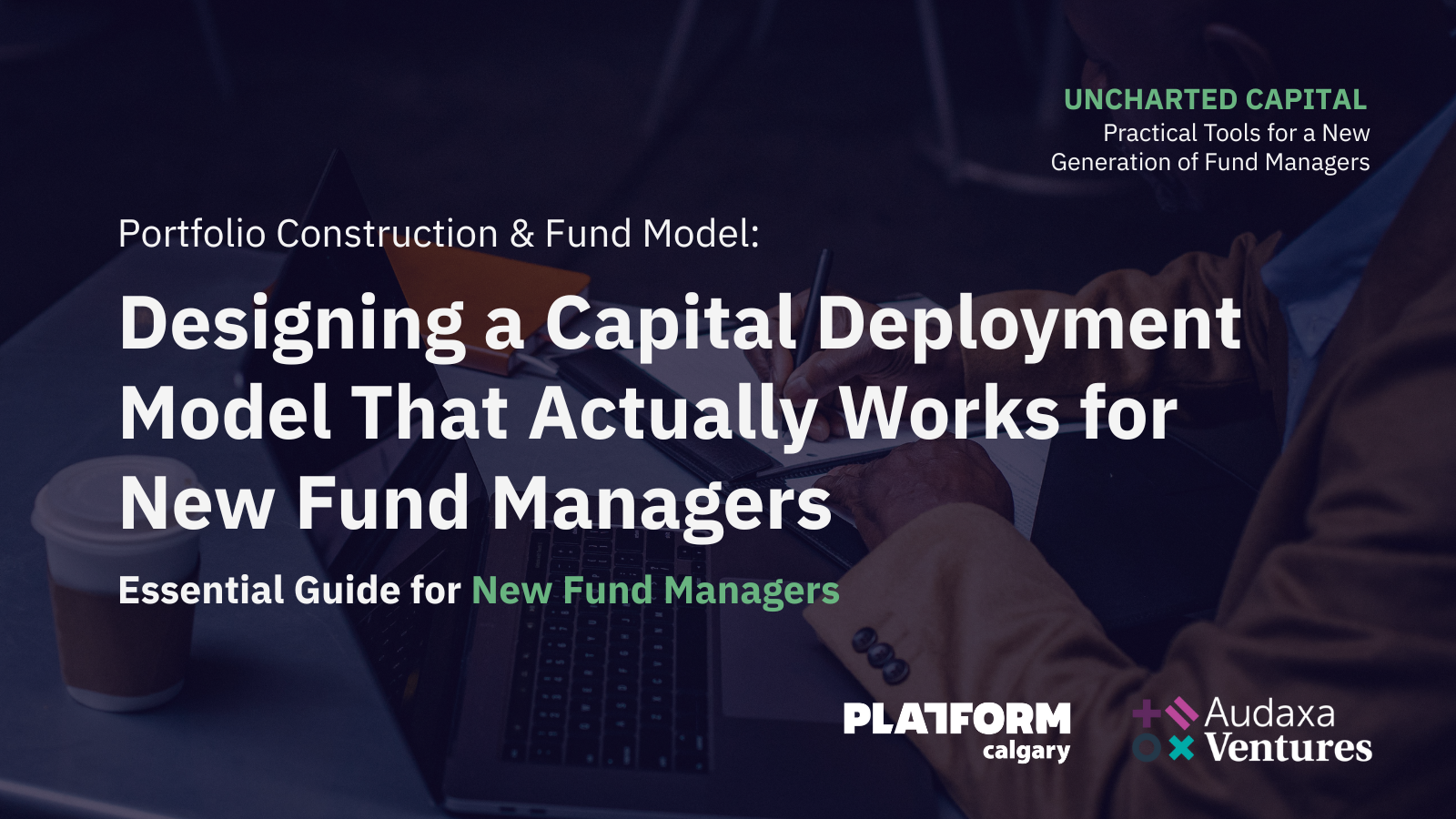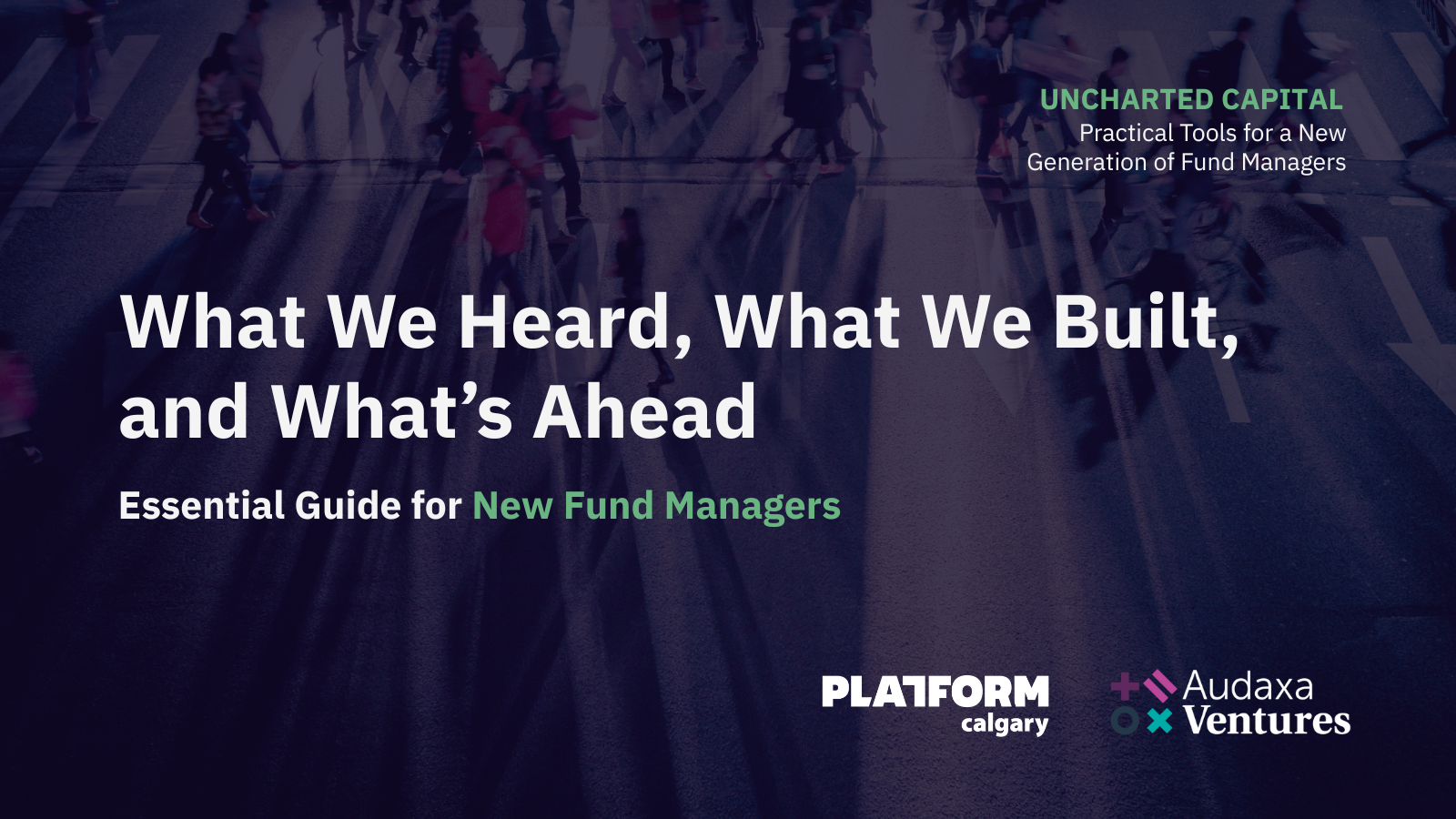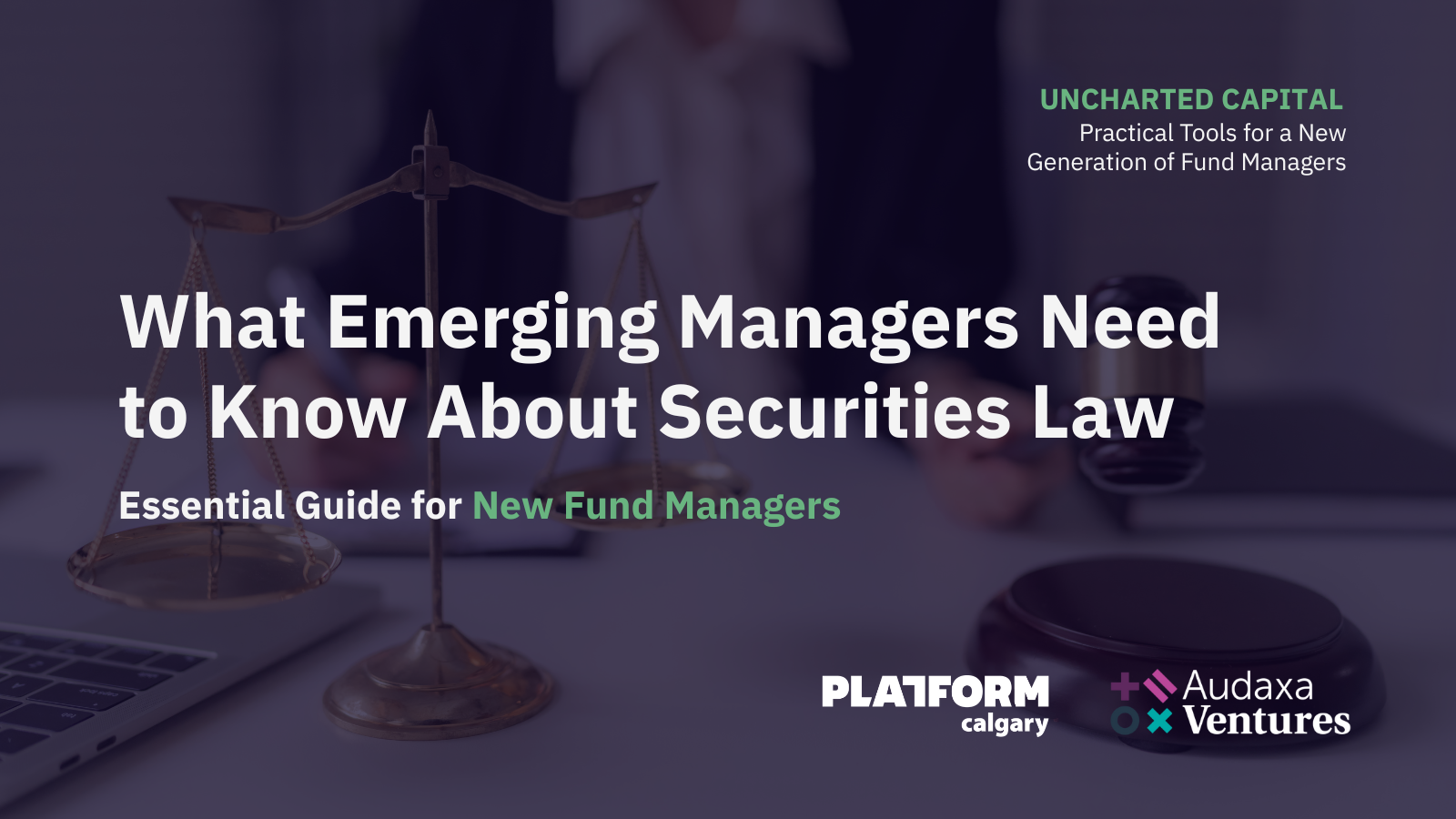Portfolio Construction & Fund Model: Designing a Capital Deployment Model That Actually Works for New Fund Managers

Platform Calgary is a non-profit, member based organization. Our mandate is to bring together the resources of Calgary's tech ecosystem to help startups launch and grow at every step of their journey, from ideation through to scale.
More about Platform CalgaryPortfolio Construction & Fund Model: Designing a Capital Deployment Model That Actually Works for New Fund Managers
Getting Real About the Math, the Model, and the Mission
By Raissa Espiritu & Hilary Kilgour, Audaxa Ventures in Collaboration with Bilal Rasool, Platform Calgary
Preface
This is the second chapter in the Uncharted Capital series—a collaboration between Audaxa Ventures and Platform Calgary designed to offer grounded, practical insight for new and emerging fund managers across Canada.
In our first piece, we explored how fund managers can establish a differentiated thesis and design fund structures that reflect their values, target markets, and strategic edge.
Now, we’re diving into the next big challenge: how to design a portfolio and capital deployment model that actually works.
This piece is grounded in our June 10 roundtable discussion with emerging GPs, ecosystem leaders, and featured guest Arden Tse of Yaletown Partners, Accelerate Fund and reflects what’s really happening behind closed doors when it comes to check size, pacing, ownership, and fund math.
This isn’t theoretical—it’s what we’re all navigating, building, and adjusting in real time.
The Importance of Portfolio Design in Venture Capital: Balancing Vision with Reality
When you're building a fund, everything sounds exciting in the pitch deck—until you start mapping out how much capital to deploy, what ownership targets are realistic to ensure return, and how to make the math add up across however many investments you plan to make.
Portfolio construction is where strategy gets tested against actual constraints: fund size, stage focus, founder pipeline, follow-on capacity, and the expectations of LPs who need more than just a compelling story—they need a path to returns.
“Every company needs to have the potential to return a third of the fund.” – Roundtable Participant
This kind of clarity doesn’t come from spreadsheets alone. It comes from honest conversations—like the ones we had in this session—about how your fund model aligns with your thesis, and how both need to evolve in a shifting market.
Ground Your Fund’s Thesis in Real-World Data and Market Opportunity
A strong investment thesis may win early interest, but how you deploy capital is what builds trust with LPs and delivers returns to investors.
“What separates thesis and fund structure is how you see value—and how all the pieces fit together.” – Arden Tse, Yaletown Partners
At this stage, GPs need to define:
- Target check sizes: What’s realistic for your fund size, and how does it affect ownership targets?
- For example: One participant cited wanting to ensure they hold at least a 6-7% equity stake when making their first cheque, and to be able to maintain pro rata rights through follow-on investments so that they don’t get diluted extensively over rounds.
- For example: One participant cited wanting to ensure they hold at least a 6-7% equity stake when making their first cheque, and to be able to maintain pro rata rights through follow-on investments so that they don’t get diluted extensively over rounds.
- Stage and pacing: Are you writing cheques early, opportunistic checks or aiming to lead? Will you reserve capital for follow-ons?
- For example: One needs to consider if they are the lead, how much capital from their management fees do they have allocated toward legal fees or technical assessments as these can be costly.
- On opportunistic investing, some funds suggested having at least 10% of allocated fund deployment set for “opportunities” that might be out of the thesis but have a profile that could have maximum Return on Investment. At Audaxa Ventures, we do this but the investment still needs to be made toward a women or non-binary founder even though out of general scope of our fund that is focused on the intersection of Climate and Health. A potential example for us would be an investment in a fintech that is diverse-led and focused on equitable financing.
- Portfolio size: How many companies can you support with meaningful capital and time?
- Your fund size and internal capacity dictate how many companies you can effectively back. Avoid overpromising support if you don’t have the team to sustain it.
For some, like Arden and the Yaletown team, early-stage investing isn’t just a thesis—it’s a system. They've evolved their Accelerate Fund series over multiple iterations, refining check sizes, pacing, and return modeling as they’ve gained deeper insight into the Alberta and Western Canadian startup landscape.
“The math has to math. If it doesn’t—no matter how good the story is—it’s going to fall apart.” – Arden Tse
Scaling Your Fund: How to Design Models That Work in Today’s Market
In our breakout sessions, fund managers shared how their models have evolved—often in response to hard-won lessons.
- One manager shared that they initially relied on a syndicate model, but transitioned to a GP/LP structure to create long-term sustainability.
- Another had an evergreen model but in order to ensure they received Institutional funding, re-positioned as a LP/GP fund structure.
- Others spoke about adjusting fund timelines, building in reserve capital, and being more rigorous about founder due diligence, including full team interviews.
“We learned the hard way: know the team, not just the idea. Everything else rests on that.” – Roundtable Participant
Some are shifting stage focus—from B2B SaaS to blockchain, AI, and healthtech—not because it’s trendy, but because that’s where they see alignment between talent, market timing, and potential acquirers.
“If the tech works, the question is—what does it need to succeed? Who’s going to buy it? That needs to be clear before you write the check.” – Arden Tse
The Role of Pacing and Flexibility in Fund Deployment for New Fund Managers
Emerging managers often underestimate the pressure of timing. The reality is that how fast you deploy and when you reserve capital can make or break your fund.
“You’re investing maybe 30% of your time—the other 70% is prepping for your LPAC.” – Roundtable Participant
Some funds are moving toward rolling first and second closes, while others are building flexibility into their capital stack by mixing philanthropic or catalytic capital alongside traditional LP dollars.
A few managers are also incorporating liquid or near-liquid assets—not for short-term liquidity, or the secondary market, to respond to LP needs and hedge against the long hold periods endemic to early-stage VC.
Impact, Inclusion, and Building a Fund That Delivers More Than Financial Returns
For funds like Audaxa Ventures, building impact into the portfolio isn't just about who gets funded—it’s also about how you define return.
As one participant asked:
“How do you measure impact on economic development when the companies you back are leaner, hire less, and still grow faster?”
The truth is, metrics are evolving. We heard candid reflections about moving from headcount-based metrics to ones focused on health outcomes, cost of care, or regional innovation.
Other funds are experimenting with revenue-based finance, loan guarantees, or anchor investors that unlock co-investment—all as ways to de-risk early investments while staying mission-aligned.
Published on
July 30, 2025
Tags
Explore more posts

For Investors
Uncharted Capital: What We Heard, What We Built, and What’s Ahead
Over the past year, we’ve explored the realities of fund building in Canada: how to design a thesis that actually reflects your edge, how to construct a portfolio that makes sense in this market, how to engage diverse founders in ways that are meaningful and not performative, how to measure impact without falling into the traps of vanity metrics, and what emerging managers needs to know about securities law.

For Startups
Celebrating Platform Incubator Cohort 4: A Year of Growth, Grit, and Game-Changing Momentum
Over the past 12 months, the founders in Platform Incubator Cohort 4 proved exactly what’s possible when determination, discipline, and community come together. These entrepreneurs navigated uncertainty, refined their products, pursued market clarity, and pushed their companies forward with conviction—and the results speak for themselves.

For Investors
What Emerging Managers Need to Know About Securities Law
For this chapter, Audaxa Ventures sat down with the investment management law team at the Calgary office of Borden Ladner Gervais LLP (BLG) to unpack the legal journey every emerging fund manager faces. We approached this conversation not as lawyers, but as operators, asking the questions we wish someone had answered before our first close.






